Change Temperature to Papyrus but Its Actually Funny
We'd need another book, of course, to do this justice. And where would one start?
Fonts are like cars on the street–we notice only the most beautiful or ugly, the funniest or the flashiest. The vast majority roll on regardless. There may be many reasons why we dislike or distrust certain fonts, and overuse and misuse are only starting points. Fonts may trigger memory as pungently as perfume: Gill Sans can summon up exam papers. Trajan may remind us of lousy choices at the cinema (you'll see it on the posters of more bad films than any other font) and grueling evenings with Russell Crowe. There was a time when it looked as though he would only appear in films–A Beautiful Mind; Master and Commander; Mystery, Alaska–if the marketing team promised to use Trajan in its pseudo-Roman glory on all its promotional material (There is a funny and rather alarming YouTube clip about this.)
Most of the time we only notice typeface mistakes, or things before or behind their times. In the 1930s, people tutted over Futura and predicted fleeting fame; today we may be outraged by the grunge fonts Blackshirt and Aftershock Debris, but in a decade they may be everywhere, and a decade after that we may be bored with their blandness. Fortunately, choosing the worst fonts in the world is not merely an exercise in taste and personal vindictiveness–there has been academic research. In 2007, Anthony Cahalan published his study of font popularity (or otherwise) as part of Mark Batty's Typographic Papers Series (Volume 1). He had sent an online questionnaire to more than a hundred designers, and asked them to identify: A) the fonts they used most B) the ones they believed were most highly visible C) the ones they liked least.
The Top Tens were:
Used Regularly:
- Frutiger (23 respondents)
- Helvetica/Helvetica Neue (21)
- Futura (15)
- Gill Sans (13)
- Univers (11)
- Garamond (10)
- Bembo
- Franklin Gothic (8)
- 9. Minion (7)
- 10. Arial
Highly Visible:
- Helvetica/Helvetica Neue (29)
- Meta (13)
- Gill Sans (9)
- Rotis (8)
- Arial (7)
- ITC Officina Sans (4)
- Futura (3)
- Bold Italic Techno; FF Info; Mrs Eaves; Swiss; TheSans; Times New Roman (2)
Least Favorite:
- Times New Roman (19)
- Helvetica/Helvetica Neue (18)
- Brush Script (13)
- Arial
- Courier (8)
- Rotis
- Souvenir (6)
- Grunge Fonts (generic) (5)
- Avant Garde
- Gill Sans (4)
- Comic Sans (3)
The Least Favorite survey contained brief explanations. Twenty-three respondents said the fonts were misused or overused; 18 believed they were ugly; others found them to be boring, dated, impractical or clichéd; 13 expressed either dislike or blind hatred.
This was not the first such survey to be conducted. There seems to be a new one every year online, but they tend to concentrate, rightly, on best fonts. Occasionally a novel theory emerges, such as the opinion expressed by the designer Mark Simonson on the Typophile forum. Simonson believes that some typefaces are 'novice magnets', possessing properties that draw in those with an untrained eye but a desire to impress. 'To the average person, most fonts look more or less the same. But, if a typeface has a strong flavour, it calls attention to itself. It's easy to recognize and makes people feel like they know something about fonts when they recognize it. And it looks "special" compared to normal (i.e., boring) fonts, so using it makes their documents look "special." To the experienced designer, such typefaces have too much flavour, call too much attention to themselves, not to mention the fact that they often carry the baggage of being associated with amateur design."
The choice of the Worst Typefaces in the World that follows may appear to be purely subjective, like the choice of most reviled pop singer or most hilarious fashion crime. And so it is. But there is also a broad consensus about what constitutes awfulness in type. As we have seen, the one thing that most people (type professionals and laypeople combined) agreed on is that Comic Sans is no good at all. But it is harmless and even benign, and, on account of its unassuming beginnings, perhaps does not deserve the loathing that has been heaped upon it. But what can you say about the virtually illegible outer-limits fonts: Grassy, for example: a type with hair; or Scrawlz, which looks like writing by a 3- or 103-year-old?
These targets, though, are just too easy, and it would be like criticizing your child's acting in the nativity play. By contrast, the names in the list below, designed by professionals for reward and approval, have had it coming for a while. Here then, in reverse order, are my nominations for the eight worst fonts in the world.
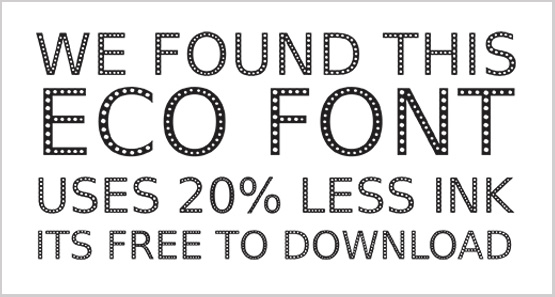
#8: Ecofont
One ought to approve. Ecofont is designed to save ink, money and eventually the planet, but heaven save us from worthy fonts. Ecofont is a program that adds holes to a font. The software takes Arial, Verdana, Times New Roman and prints them as if they had been attacked by moths. They retain their original shape, but not their inner form, and so lose their true weight and beauty. They also usually go no bigger than 11pt, although at this size or smaller they may save you 25 percent of ink consumption.
The plus side: In 2010 Ecofont won a European Environmental Design Award. The downside: a study at the University of Wisconsin claimed that some Ecofont fonts, such as Ecofont Vera Sans, actually use more ink and toner than lighter regular fonts such as Century Gothic (although one could, of course, always print Century Gothic using Ecofont software).
The verdict: the string vest and Swiss Cheese of fonts; a nice idea for printing large documents in draft–but do you really need to print them at all?
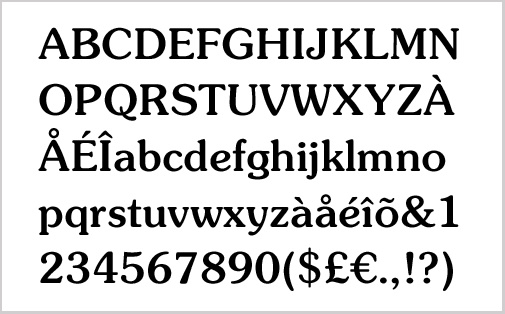
#7: Souvenir
"Real men don't set Souvenir," wrote the type scholar Frank Romano in the early 1990s, by which time he had already been performing character assassination on the type for over a decade. At every opportunity in print and online, Romano would have a go. 'Souvenir is a font fatale . . . We could send Souvenir to Mars, but there are international treaties on pollution in outer space . . . remember, friends don't let friends set Souvenir.'
Romano is not alone; Souvenir seems to infuriate more type designers than practically anything else. Peter Guy, who has designed books for the Folio Society, wonders, 'Souvenir of what, I would like to know?' He has a possible answer: 'A souvenir of every ghastly mistake ever made in type design gathered together–with a few never thought of before–into one execrable mish-mash.' And even the people who sell it hate it. Here is Mark Batty from International Typeface Corporation (ITC) on one of his best-selling fonts: 'A terrible typeface. A sort of Saturday Night Fever typeface wearing tight white flared pants . . . '
Souvenir was the Comic Sans of its era, which was the 1970s before punk. It was the face of friendly advertising, and it did indeed appear on Bee Gees albums, not to mention the pages of Farrah Fawcett–era Playboy. Oddly, though, Souvenir was far from a seventies face. It was cut in 1914 by the American Type Founders Company, one of the many fonts of Morris Fuller Benton. After a bit of attention it died away, and that would have been that, had it not been revived by ITC half a century later and given a big push in the heyday of photocomposition.
Souvenir has been in the wilderness for two decades, hiding from a design community critical of anything once described as "warm and fuzzy," but bizarrely it is almost hip again, at least in the pages of the design magazines. One may be rightfully suspicious of ironic retro patronage, but in this case there is genuine enthusiasm. "Every character is a graphic icon, but as a typeface it is still harmonious," believes Jason Smith, the founder of the Fontsmith foundry, who once chose the lowercase g of Souvenir Demi Bold as his favourite single character of all time ("the soft terminals and rounded organic body—gorgeous").
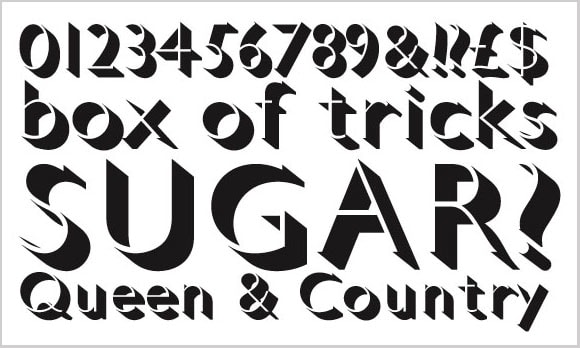
#6: Gill Sans Light Shadowed
Gill Sans Light Shadowed is the sequel that should never have been made–a font that pleases the taxman and no one else. It's hard to believe that this is what Eric Gill had in mind when he first picked up chisel and quill–a type design that would combine the look of both but ultimately end up redolent only of crackly Letraset on a school magazine.
Gill Sans Light Shadowed is an optical font defined by its black dimensional shadow, designed to suggest the effect the sun would cast over thin raised letters. Like an Escher drawing, it will soon induce headaches, the brain struggling to cope with the perfection and exactitude.
There are a great deal of similar three-dimensional effects on the market, the majority from the late 1920s and 1930s–Plastika, Semplicita, Umbra, and Futura Only Shadow–and many digital shaded fonts such as Refracta and Eclipse suggest the trend has not worn itself out. Like the many fonts designed to resemble old-fashioned typewriters–Courier, American Typewriter, Toxica–the effect amuses for a very limited time, leaving cumbersome words that are difficult to read and lack all emotion.

#5: Brush Script
If, during the 1940s, you were ever persuaded by government posters to bathe with a friend or dig for victory, the persuading was probably done in Brush Script. If, during the 1960s or '70s, you worked on a college or community magazine, then Brush Script screamed, Use me, I look like handwriting. If, during the 1990s, you ever perused the menu of a local restaurant (the sort of restaurant opened by people who on a starlit evening thought, "I'm a pretty good cook–I think I'll open a restaurant!"), then that menu had a good chance of featuring Pear, Blue Cheese and Walnut Salad on a Bed of Brush Script. And if, in the twenty-first century, you ever even momentarily considered putting Brush Script on any document at all, even in an ironic way, then you should immediately relinquish all claims to taste.
Brush Script was made available by American Type Founders (ATF) in 1942, and its designer Robert E Smith gave it a lower case with joining loops, creating a quaint and consistent type that looked as if it was written by a fluid, carefree human. The problem was, no one you had ever met actually wrote like that, with such perfect weight distribution and no smudges (and of course every f, g, and h exactly the same as the last one). But it seemed like a good type for corporations and government bodies to get what they wanted across in a non-corporate way, which is why advertisers used it so much for three decades. It was also the type that introduced Kylie Minogue, Jason Donovan and Neighbours to the world in 1985, a rare instance of opening credits that looked as though they had been written by an elderly member of the cast.
Brush Script inspired a hundred more handwriterly alternatives–Mistral, Chalkduster, Avalon, Reporter, Riva. Many of these are rather nice, and some (Café Mimi, Calliope, and HT Gelateria) are lavishly beautiful. Every leading digital foundry offers an extensive list, ranging from childish scrawl to technical precision. But they all have one thing in common: they are trying to fool you into thinking they are not made on a computer, and they never succeed.
There are also a number of companies that offer you the chance to create a font from your own handwriting. With a site like Fontifier.com this is almost instant: you fill in an alphabet grid, upload it (with your payment) for digital rendering, and you'll be able to preview your own uniquely named type with hundreds of professional script fonts, and perhaps discover that it's better than many.
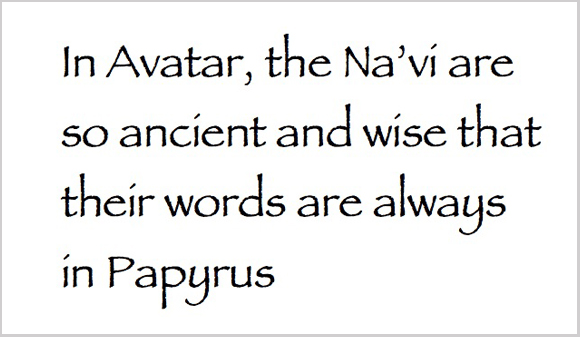
#4: Papyrus
Avatar cost more to make than any other film in history but it did its best to recoup whatever it spent on 3-D special effects and computer-generated blue people by using the cheapest and least original font it could find: Papyrus, a font available free on every Mac and PC. They did tweak it a little for the posters, but they used the standard version for credits and the subtitling for the Na'vi conversations. (On the website iheartpapyrus.com you'll see an amusing Photoshop of James Cameron briefing star Sam Worthington in a T-shirt proudly asserting "Papyrus 4 Ever!")
Cameron's choice was baffling. Papyrus is not a bad font on its own, but is so clichéd and overused that its prominent selection for a genre-busting movie seems perverse. It also seems geographically inappropriate: as everyone who has written a school project over the last decade will tell you, Papyrus is the font you use to spell out the word "Egypt."
Designed by Chris Costello and released by Letraset in 1983, Papyrus suggests what it might be like to use a quill on Egyptian plant-like material. The letters have notches and roughness, and give a good account of a chalk or crayon fraying at the edges. The primitive letters leave the impression of writing in a hurry but there is also a consistency to the style, with E and F both carrying unusually high cross-bars. The lower case seemed to be modeled closely on the early twentieth-century American newspaper favourite Cheltenham.
The font soon became a favourite of Mediterranean-style restaurants, amusing greeting cards, and amateur productions of Joseph and his Amazing Technicolor Dreamcoat (long title–good in Papyrus Condensed), and its digital incarnation proved perfect for the desktop publishing boom of the mid-1980s. It said adventurous and exotic, and marked its user out as a would-be Indiana Jones. Its use in Avatar was a remarkable notch up–and another example of growing typographic literacy as moviegoers scratched their heads and wondered where they had seen those titles before.

#3: Neuland Inline
Are you out this evening to see an amateur stage version of a musical involving an animal called Pumbaa and another called Timon, with songs performed by a junior Elton John? Good luck! While you're there, take a look at the poster. More likely than not it will be in Neuland or Neuland Inline. The Neuland family says Africa in the same way as Papyrus says Egypt, albeit the it's-all-good safari/spear-dance side of Africa rather than the shantytown or Aids side. It is a dense and angular type, suggestive of something Fred Flintstone might chisel into prehistoric rock. The inline version is bristling with energy and a quirkiness of spirit, a bad type predominantly through its overuse rather than its construction.
Neuland was created in 1923 by the influential typographer Rudolf Koch, who also made Kabel, Marathon and Neufraktur. At the time of release it was so far removed from other German types (both blackletter and the emerging modernists) that it was widely regarded with derision – too clumsy and inflexible. But its individuality soon became its strength, and by 1930 it had been adopted to advertise products that thought of themselves as special: the Rudge-Whitworth four-speed motorcycle; Eno's Fruit Salts; American Spirit cigarettes. Some time later, as with Papyrus, Neuland hit the big time in the movies–with the type almost as prominent in Jurassic Park as the dinosaurs.
Both Neuland and Papyrus are classifiable as theme park fonts, more comfortable on the big rides at Universal Studios, Busch Gardens or Alton Towers than they are on the page. There are many other display types that share this dubious attribute, and the enterprising man behind a site called MickeyAvenue.com has spent a great deal of time at Walt Disney World Resort in Florida noting them all down. We now know to expect Þ at the Corner Café on Main Street, and w at the Haunted Mansion, while x, which was put on this earth to spell the word y, is at Magic Kingdom's Fantasyland. The classics, too, show up in places their designers could never have envisaged. Albertus reigns at the Animal Kingdom Oasis area; Gill Sans provides signage at the Epcot Imagination zone; Univers does its usual information duty at transportation and ticketing areas, while Futura is at the Animal Kingdom's Dino Institute.
You may write to the MickeyAvenue webmaster thanking him for his sterling endeavours. You will receive a reply thanking you for your communication written–of course–in Papyrus.
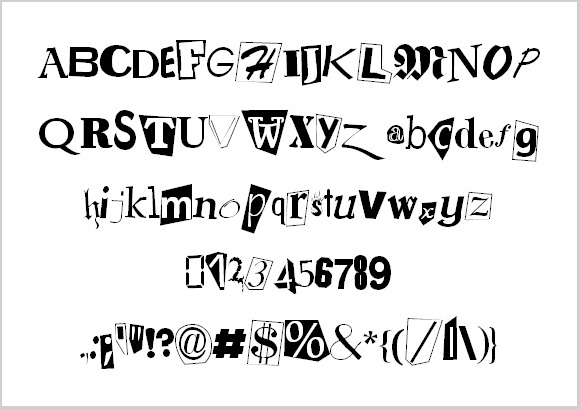
#2 Ransom Note
As you might expect, Ransom Note consists of letters that look as if they have been hurriedly cut from magazines to form unnerving messages. There are various styles of such fonts available, many of them downloadable free of charge, and you might use them to write such things as "Pay up or the kitten gets it." Inevitably these menaces don't look very realistic, and Ransom Note is a font best used for comic effect, perhaps to say "Christian is having another bloody paintballing birthday party–please do come."
The names are often better than the type–BlackMail, Entebbe, Bighouse. None of them, however, have a genuine ransom note's sweat, glue, and menace, nor the cut-up shock-art of those original Sex Pistols record sleeves.
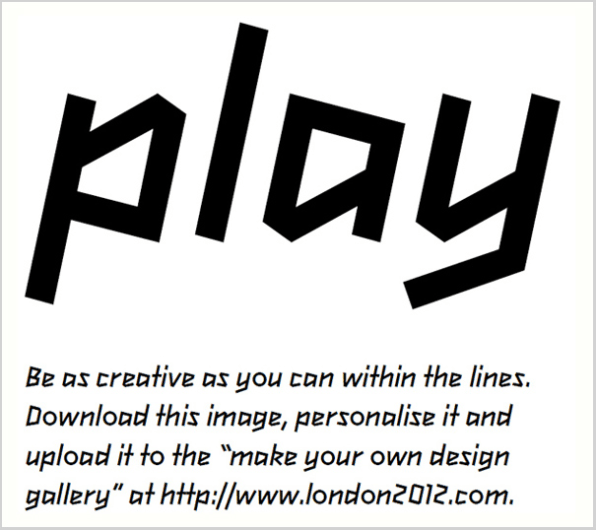
#1 The 2012 Olympic Font
Precisely 800 days before the Olympic Games were due to start, the Official London 2012 shop began selling miniature die-cast taxis in pink, blue, orange and other shades, the first of forty such models, each promoting a different sport. The cabs are not like the lovingly crafted ones you can buy from Corgi, with opening doors and jewelled headlights, more the lumpy ones sold in Leicester Square to tourists in a hurry. Why should this matter? Because they are an example of very bad design, something London has largely begun to shun in recent years. What makes them doubly bad is the packaging, which comes with a bit of trivia about all the Olympic and Paralympic sports, each heralded with the question "Did You Know?" in what is surely the worst new public typeface of the last 100 years.
The London 2012 Olympic Typeface, which is called 2012 Headline, may be even worse than the London 2012 Olympic Logo, but by the time it was released people were so tired of being outraged by the logo that the type almost passed by unnoticed. The Logo was the subject of immediate parody (some detected Lisa Simpson having sex, others a swastika), and even the subject of a health warning–an animated pulsing version was said to have brought on epileptic fits. In the International Herald Tribune, Alice Rawsthorn observed that "it looks increasingly like the graphic equivalent of what we Brits scathingly call–'dad dancing'–namely a middle-aged man who tries so hard to be cool on the dance floor that he fails."
Like the logo, the uncool font is based on jaggedness and crudeness, not usually considered attributes where sport is concerned. Or maybe it's an attempt to appear hip and down with the kids–it looks a little like the sort of tagging one might see in 1980s graffiti. It also has a vaguely Greek appearance, or at least the UK interpretation of Greek, the sort of lettering you will find at London kebab shops and restaurants called Dionysus. The slant to the letters is suddenly interrupted by a very round and upright o, which may be trying to be an Olympic Ring. The font does have a few things going for it: it is instantly identifiable, it is not easily forgettable, and because we'll be seeing so much of it, it may eventually cease to offend. Let's hope they keep it off the medals.
From Just My Type by Simon Garfield. Published by arrangement with Gotham Books, a member of Penguin Group (USA) Inc. Copyright © 2010 by Simon Garfield.
Click here to buy the book on Amazon for $17.
Source: https://www.fastcompany.com/1665318/the-8-worst-fonts-in-the-world
0 Response to "Change Temperature to Papyrus but Its Actually Funny"
Post a Comment